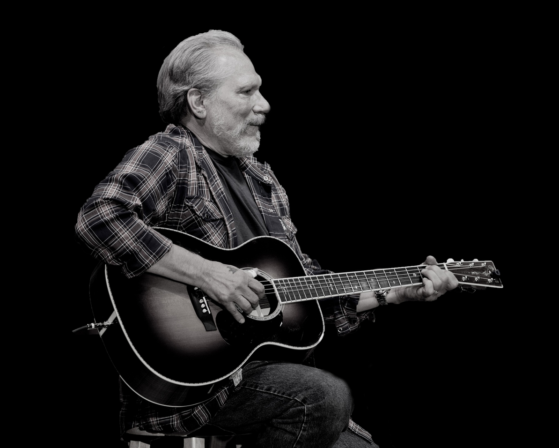
Jorma Kaukonen Reflects on ‘Surrealistic Pillow’ And The Life of a Legendary Band
In 1967, San Francisco rockers Jefferson Airplane released “Surrealistic Pillow,” an album that put the Haight-Ashbury hippie scene on the commercial map and featured the band’s two biggest hits, “Somebody to Love” and “White Rabbit.” An unprecedented and unmatched mix of Peter, Paul and Mary’s harmonious folk-revival music, Howlin’ Wolf’s overdriven guitar blues, Bo Diddley and Chuck Berry’s driving early rock and roll, and melodic pop-rock à la “Revolver”-era John Lennon, “Surrealistic Pillow” offers a spooky and intense vision of psychedelia that stands in striking contrast with the more carefree sounds of other psychedelic music, in its era and since. The Harvard Crimson spoke with Jorma Kaukonen, Jefferson Airplane’s lead guitarist and sometime singer-songwriter, about the making of the album and more.
The Harvard Crimson: Rick Jarrard produced “Surrealistic Pillow.” What did that mean, exactly?
Jorma Kaukonen: Rick really took an active role in how things were evolving in the studio. He had a lot to say. “We need a guitar accent here,” or “we need a solo there,” et cetera. We also had Jerry [Garcia, of the Grateful Dead] on board, and he helped us with arrangements and with band dynamics, because he had so much more familiarity with that stuff, but Rick Jarrard was the producer.
THC: Was there ever tension between Jarrard and the band over his creative input?
JK: We sort of bristled against some stuff, just ‘cause we liked to think we came up with everything ourselves. But at the same time, I think that everybody in the band, even Paul, Grace, and Marty [Kaukonen’s bandmates] recognized that we were in uncharted waters. When you go into the studio and record something, it’s a different ballgame from playing a live show. I don’t think the album would have had the same sonic quality had the members of the Airplane, myself included, been able to drive the bus more. So, did Rick make us do stuff that we probably wouldn’t have done if left on our own? The answer is yes, and after the fact, my personal opinion is that this was a good thing.
THC: What sorts of things did Jarrard push for?
JK: One example is that when he heard me playing “Embryonic Journey” in the lobby to the security guard, just for fun, he said “I want to put that on the record.” And I thought he’d lost his mind, to put a folky fingerpicking piece on a rock and roll record. He recorded that in one take, and all the echo on it is real room echo.
THC: I’ve always assumed that the echo was applied in post-production. Did he put the mic, like, fifteen feet away from you?
JK: The mic was probably pretty close to the guitar. I wish I could say I remember, but I don’t. But that’s something else, too: recording guys like Rick, these guys were masters of mic placement. RCA had two books out in the ‘50s about mic placement, more about recording classical music and orchestras, that are still kind of the Bibles for guys that are interested in that kind of stuff. And those guys, back in the old days, they had that stuff down.
THC: You’ve said that when you first joined Jefferson Airplane, you were asked to play a Rickenbacker twelve-string because Roger McGuinn [lead guitarist and singer of the Byrds] used one. When you were making “Pillow,” did you think about emulating your contemporaries, like “I’ll play a Hendrix-y lick here,” or avoiding sounding like them?
JK: The answer is no. First of all, I don’t think we’d heard Hendrix yet, although he went on to be so influential on so many levels. Second of all, I recognized early on that what McGuinn did with the Byrds was utterly alien. It was really cool, and he’d architected a guitar sound that was completely his own, but I just played like me; I wasn’t able to do what he did. I think Paul would have been happy if I’d been able to do that, but the twelve-string didn’t last long in the Airplane, because that just really wasn’t me.
THC: There’s a polyphonic approach to vocal arranging across the album there that I don’t really hear in any other ‘60s rock music. In the B section of “She Has Funny Cars,” for instance, Marty and Grace have dueling vocal lines, instead of harmonizing lines. Where did that come from? It seems like a classical idea.
JK: That call-and-answer thing, with Grace and Marty, it’s just the chemistry of these two people. Grace had some classical training, and she liked Erik Satie [fin-de-siècle French avant-garde composer] a lot, and I’m guessing that she was probably driving that. I mean, nobody would have told anybody what to do, ‘cause it didn’t work like that, but the vocal harmonies of the Jefferson Airplane were very idiosyncratic. From the beginning to the end of our thing as a band, there’s some really interesting stuff.
THC: Are there any bands around today that you think are doing the kind of work you were trying to do, carrying the torch?
JK: One of the bands that I’m extremely fond of for a number of reasons –– and I don’t think they’re influenced by us on any level, but they carry the same kind of spiritual torch — is [Lake Street Dive. I just love that band; they’re great. And no matter what Rachael Price [Lake Street Dive’s singer] and her pals are going for or how they see themselves, they’re not a typical rock and roll band. They’re not a typical jazz band. In my opinion, they really are their own thing, whatever that thing is. And if nothing else, in the era when the Airplane was young, the Airplane was absolutely its own thing.
—Staff writer Alasdair P. MacKenzie can be reached at [email protected].
Source:
https://www.thecrimson.com/article/2019/7/29/jorma-kaukonen-surrealistic-pillow-jefferson-airplanes/